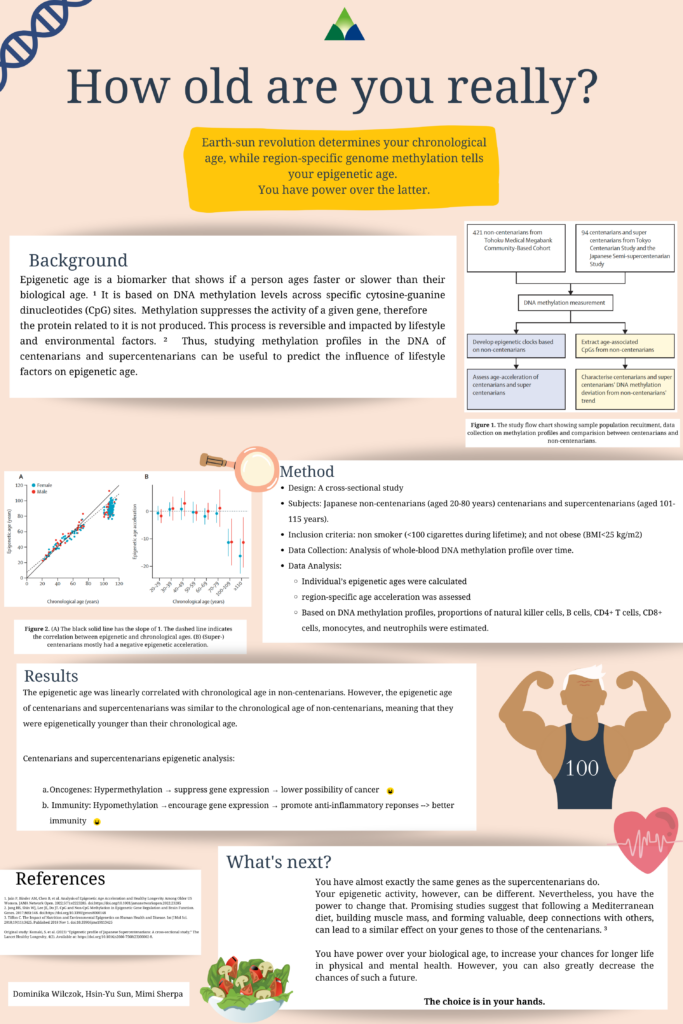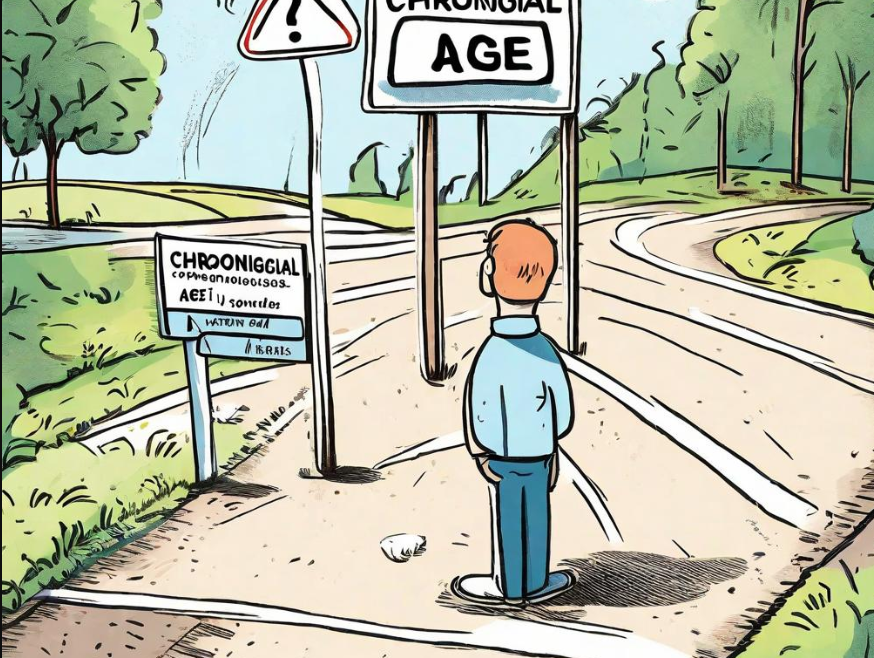What if I told you that your birth certificate is lying? That you are of a different age than you always thought? No, this is not another post telling you that age is just a number. Welcome to the introduction to 

The difference between biological and chronological age
Chronological age is the number of years that passed since you were born. You have no influence over it; the earth goes around the sun whether you want it or not.
Biological age shows the extent of damage to your organism that you accumulated over that time. The damage to your organism isn’t necessarily visible. It can be obvious such as wrinkles or hidden, like, shortened telomeres. Your lifestyle choices immensely impact your biological age. “Healthy” lifestyle minimizes and prevents the damage, while “unhealthy” one accelerates the damage. You have power over how damaged your organism is, and therefore over your biological age. You can make it smaller or bigger. It will be bigger that yur chrolonlogical age, when your body is more damaged than a typical person your age and vice versa. Dr. Karla Fitzgerald showed that just 8 weeks of “healthy lifestyle” intervention can reverse the biological age by 3 years (see sources).
What causes the damage is a whole other topic, which is still debated. Welcome to read the post on one of the suspected reasons: senescent cells. How to measure the damage, though?

(4) (PDF) The Impact of Exercise on Telomere Length, DNA Methylation and Metabolic Footprints. Available from: https://www.researchgate.net/publication/357626348_The_Impact_of_Exercise_on_Telomere_Length_DNA_Methylation_and_Metabolic_Footprints [accessed Sep 21 2023].
How is the biological age calculated?
We use biomarkers to measure biological age. Biomarkers are indicatiors of processes happening in your body. When you feel bad for a long time the doctors will likely test your blood. They do this to see what substances inside you are of different concentrations than they should be. Scientists run tests on hundreds of thousands of people to determine the healthy norm of these markers. Then they compare your blood results to those of many people who don’t have your symptoms. Aging biomarkers work in the same way, however, the norm in this case is a person of your chronological age.
Warning! The ranges here are hypothetical! Let’s say that you are 57 years old woman. The norm of LDL cholesterol for your age group is 50 mg/dL or more. The research shows that most people in their 30ties have 50 mg/dL of cholesterol. The average value for the 40-50 age group is 60 mg/dL, 50-60 is 70 mg/dL, and so on. In reality, it does not increase so linearly. Nevertheless, if you are 30 yers old, but your HDL cholesterol is 70 mg/dL and not 50, as expected from your age group norm, you will appear older to the algorithm. If the algorithm knew nothing about you except for your HDL levels, it would assign you to an older age group.
Research showed that people who smoked looked older to the algorithm than non-smokers, even though chronologically they were the same age. Simplifying, smoker’s biomarkers were worse, than non-smokers. This indicated that their organism is more damaged and, therefore looked older.

What makes biomarkers suitable?
The changes in biomarkers appear with age. For any characteristic to be a biomarker, it needs to meet the following criteria:
- Must be a better indicator of how soon you’ll die than your chronological age. Intuitively, the older we are the closer we are to death. However, compare a 30-year-old patient with incurable cancer, and a fit 60-year-old. In this case, the odds of living longer favor the older one. Therefore, an aging biomarker should know if the specific damage in your body is big enough to kill you soon.
- Should show early signs of an age-related disease. The emphasis is on the word ‘early’. For example, proteins associated with Alzheimer’s disease begin accumulating in your brain about 20 years before the symptoms appear. An aging biomarker should catch such a change so that we can stop it before it becomes deadly.
- Be easily obtainable: no pain or hospitalization. Should be as easy as a mouth swab or blood sample taking at most.
- Be relatively stable: a factor that shows 35 mg on Monday, 354 on Tuesday, and 17mg on Wednesday has too much variability. We can’t draw reasonable conclusions from it.
The biggest difference between young and old is how long it takes for the blood pH to get back to normal (e.g. after holding the breat for long). Others include the number of taste buds, heart rate at rest, or how clearly you see. However, the aging clocks, which are the algorithms assessing those markers and age, rely on things that are happening in your body on a smaller scale. Introducing: telomere length, DNA methylation
Examples of aging biomarkers
- Face appearance (wrinkled? Sun spots?)
- albumin levels (protein showing your liver function)
- DNA methylation at specific sites (are genes that e.g. protect you from cancer active or not?)
- total cholesterol (HDL, LDL levels?)
- cardio-respiratory fitness (for how long can you run on the treadmill with stable breath and reasonable heart rate?)
- telomere length (how long are the ends of your chromosomes)

Why should you care about biological age?
What would you do if your phone notified you that it’s battery is so hot that it might explode? If your mechanic said that your brakes are so worn out that they can stop working any minute? You’d most likely take action because
a) you paid for both your phone and your car
b) they are necessary to your daily life
Well, shocker: you need your body and mind to live and basically do anything.
In the case of disease prevention is important. Even if the patient shows up to the doctor too late, there is still a chance to fix it. When symptoms of a disease appear, doctors step in to extinguish the fire.
However, when an older person comes in with similar symptoms, the doctors say it’s normal at this age and belittle it.
However, it only holds true if we accept the current aging paradigm: getting older -> getting sick ->dying.
You don’t have to get sick. Sickness IS NOT a part of normal aging. 75% of whether you will get sick with age and how severely depends on your lifestyle choices. If that was a 75% chance to win a million dollars, would you take it? If you don’t, then open up your wallet to pay for all the meds, and schedule a therapy session to process the pain and numbness coming with the age-related diseases.
(Another reason to care is that it’s so cool to track your body’s performance and share it with friends;))

In the next post, I will discuss the broader application of these biomarkers. We use them to construct Aging clocks and deep aging clocks. A lot of AI, Deep Learning, and Machine Learning are used in this field, so prepare yourself to upgrade your IT and bio knowledge with me!
#newaging #changingtheparadigm #healthylongevity
Sources:
https://www.sciencedirect.com/science/article/pii/S1568163719302582
https://www.nature.com/articles/s41591-021-01382-x
https://www.ncbi.nlm.nih.gov/pmc/articles/PMC10085584/
Longevity Medicine 101 course by Longevity Education Hub




